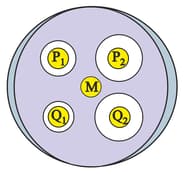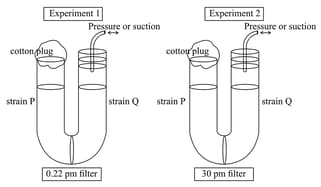Kingdom Monera
Kingdom Monera: Overview
This topic covers concepts, such as Kingdom Monera, Archaebacteria, Eubacteria, Cyanobacteria, Bacteria, Classification of Monera Based on Nutrition, Structural Features of Kingdom Monera, Nutrition in Kingdom Monera, Respiration in Kingdom Monera & Reproduction in Kingdom Monera etc.
Important Questions on Kingdom Monera
Microbes after growth on a nutritive medium forms _____.
What is the typical size of bacteria?
A typical bacteria possess a tightly bound 3-layered complex envelope - Outermost , middle and inner .
Consider the following four measures that could be taken to successfully grow chick pea in an area where bacteria blight disease is common.
(A) Spray with Bordeaux mixture.
(B) Control of the 'insect vector of the disease pathogen'.
(C) Use of only disease-free seeds.
(D) Use of varieties resistant to the disease.
Which two of the above measures can control the disease?
Which one of the following pairs is not correctly matched?
In which kingdom, bacteria are included?
What is the difference between bacteria and eubacteria?
What is the difference between bacteria and archaebacteria?
Living organisms that are most abundant and adaptable to all biological groups-
Who observed the bacteria for the first time?
The organism E. Coli belongs to which kingdom-
List out the economic importance of archaebacteria.
Bacteria can be divided into four groups based on the optimal temperatures under which they grow: psychrophiles , mesophiles , facultative thermophiles and thermophiles . Based on this information, the option that gives the best match is
| Type of bacteria | Characteristic feature | ||
| i | Thermophiles | p | are mostly human pathogens |
| ii | Mesophiles | q | cause refrigerated food to spoil |
| iii | Psychrophiles | r | cannot survive pasteurization |
| iv | Facultative thermophiles | s | found in deep sea vents |
Antibiotics P1, P2 (cell wall synthesis inhibitors), and Q1, Q2 (protein synthesis inhibitors) are equally hydrophilic and moderately toxic to humans. Staphylococcus is known to develop resistance to all these antibiotics. An experimenter tested these antibiotics against a recent pathogenic strain of Bacillus. A high density of Bacillus culture was spread on a nutrient agar plate. Filter paper discs, each soaked in P1, P2, Q1 and Q2 individually (of same concentration), were placed on the bacterial lawn (purple background in the schematic). M is mock control without any antibiotic. Following an overnight incubation, a zone of inhibition is seen around each disc, except for M. Additionally, few individual colonies were observed in zone of inhibition for P2. Based on these observations select the correct statement(s).

Conjugation in . coli is a microbial process wherein conjugative plasmids are transferred from one bacterium to another that does not possess it. This requires physical contact between the cells involved in the transfer. In an experiment performed in a sterilized U-tube, strains (resistance to ampicillin encoded in its plasmid) and (resistance to tetracycline encoded in its genome) were grown in an appropriate medium without an antibiotic. A pore size nitrocellulose membrane placed in between the two arms serves as a partition. In a parallel identical experiment the membrane was replaced by a nitrocellulose membrane. After allowing enough time for the conjugation process to occur, an aliquot from each arm is plated on either ampicillin or tetracyclin antibiotic containing plate. Choose the correct statement about the outcome of the experiment.

What are archaebacteria. Explain their types ?
Which one is the direct method for the transmission of the disease?
